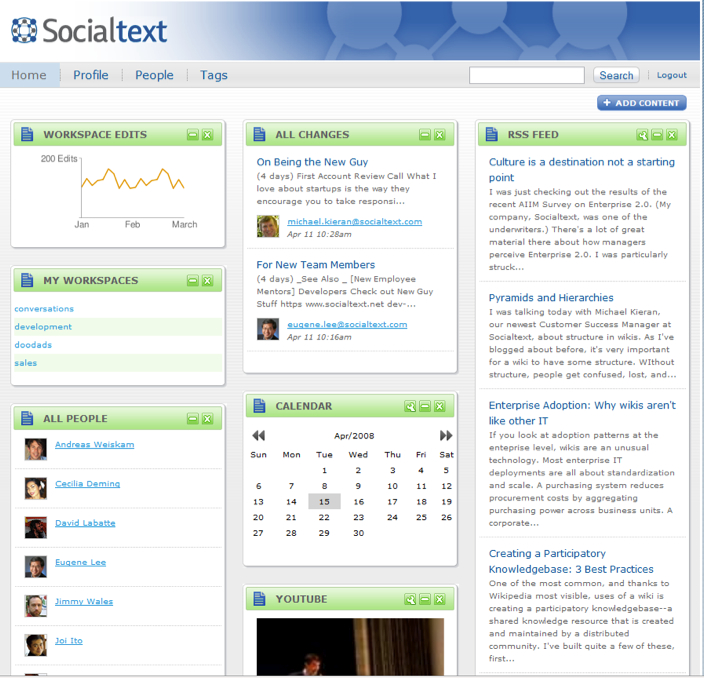SocialText moves the collaboration goalposts

I caught up with Ross Mayfield, president of SocialText today to discuss its new products, SocialText Dashboard and SocialText People. Ross believes that wikis are the foundation for collaboration within the enterprise and that Dashboard and People represent the next iteration in the way people will work. Rafe Needham says this version represents SocialText's efforts at including social networking features. While that statement is true, it belies where SocialText is going with its software and how it goes to market.
Stepping back a moment, it is clear that business is not going to get to Enterprise 2.0 by implementing a list of features like blogs, wikis, RSS and so on. While they represent facets of how an enterprise might collaborate, they need bringing together in a way that allows business to solve a multitude of problems. It is for that reason that SocialText has created four solution set scenarios. According to the press release:
- Collaborative Intelligence for sales and marketing, as implemented for market leaders including Humana and SAP
- Participatory Knowledgebase for service and support, as implemented for market leaders including Symantec and Microstrategy
- Flexible Client Collaboration for professional services, as implemented for market leaders including MWW Group and CoActive Marketing Group
- Business Social Networks for partners and customers, as implemented for market leaders including United Business Media and Epitaph Records
The solution sets represent ways of using SocialText for specific problem types. We discussed for instance how Business Social Networks might be used in supply chain situations as a way of assessing supply chain partner performance for future product assembly.
SocialText is adopting a similar approach to that of Jive, HiveLive and others by putting people at the center of the technology offering. In its case, SocialText provides a lightweight tagging capability so that people can create internal social graphs that track individual and group activity such that patterns of behavior can be discovered. In the enterprise world, who is editing what or commenting where is important at many levels. For instance, understanding how particular people are behaving helps surface talent and could be used as a way of reputation hunting.
SocialText is also including a clutch of widgets that can be loaded into the dashboard. These include a list view of Salesforce.com generated prospects, a Newsgator widget and Google News news alert. I will be interested to see whether the likes of SAP, Oracle, IBM and Microsoft recognize the value of mashing up information included in SocialText Dashboard (as an example) with transaction data. That could provide significant efficiencies in both service and supply chain operations where the ability to connect with people inside business processes but across organizational boundaries usually requires going outside the process to an email system.
SocialText is on to something here. It is elevating the notion of the wiki to something that has demonstrable and obvious business value. It is now up to the big transaction engine providers to get with the program and leverage these capabilities for the benefit of customers.
